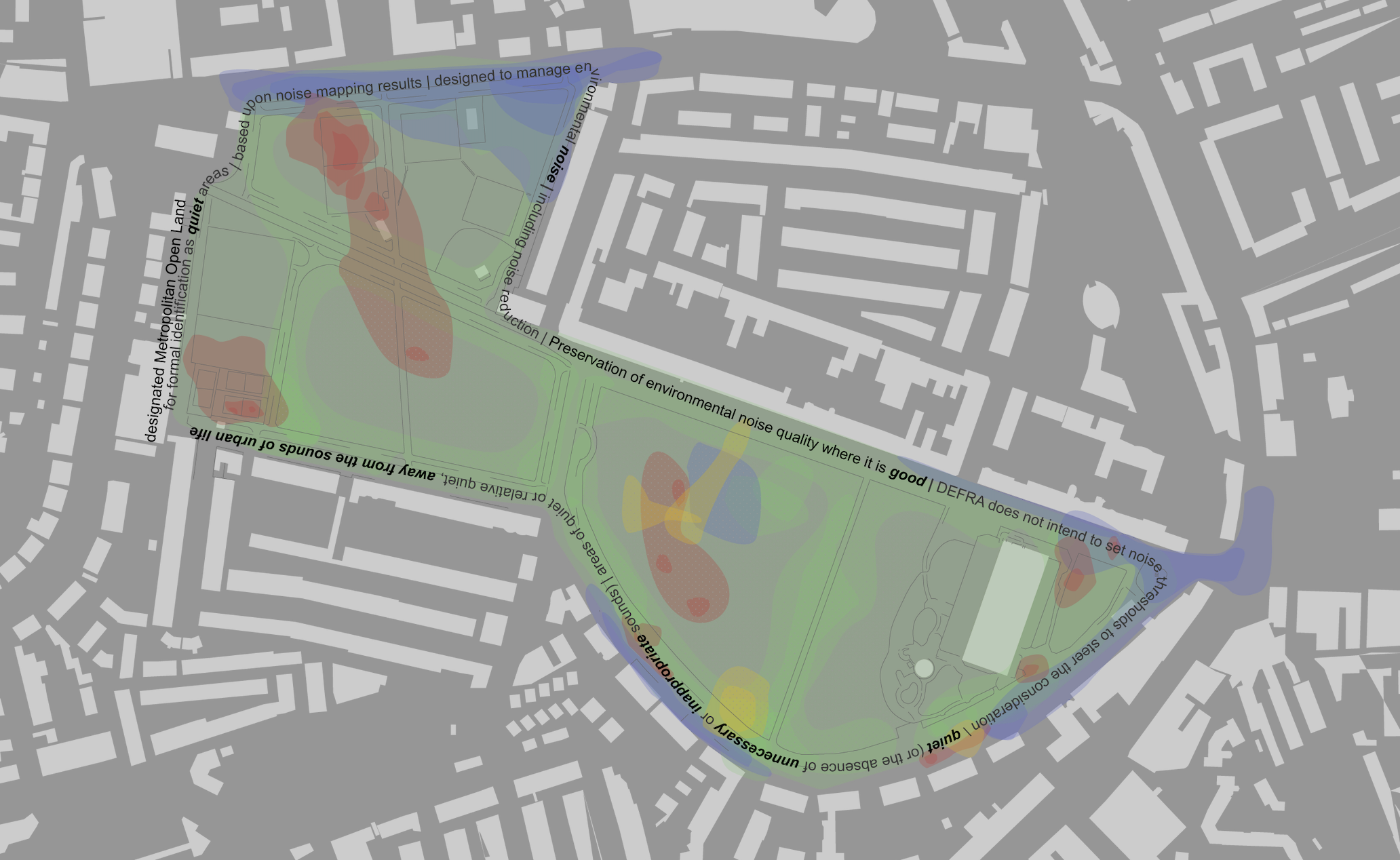Speculative Designs: Urban Sonic Ecologies
SONCITIES x CSM MA Cities
Alongside the June 2025 Quiet Urgency symposium, SONCITIES and CSM MA Cities collaborated to facilitate a speculative design process with students from postgraduate programmes across Architecture, Cities, and Industrial Design.
The cross-programme cohort began with a day-long Sprint on 18 May 2024, ‘Scoring, Mapping, Designing Urban Sonic Ecologies’, with Diana Ibañéz-López, Gascia Ouzounian, and John Bingham-Hall. The workshop introduced students—many of whom had not previously worked with sound—to key concepts in sonic urbanism, including sonic cartographies, countermapping, and the integration of sound with green infrastructure in urban policy. John presented his critique of current approaches to sonic urban policy, reorienting our understanding of urban sound ecologies through the frames of wild, commons, infrastructures. Gascia introduced scoring and mapping as methods for urban inquiry.
Students were invited to attend the Quiet Urgency symposium, and a smaller group was selected to develop speculative projects responding to its themes. These projects explored how sonic urbanism might inform critical design responses to the ‘quiet urgency’ of sonic ecologies. Designs were developed through the two workshop days following the symposium – with input from workshop participants Sven Anderson and Ella Finer – and a follow-up series of tutorials and pin-ups with John, Diana, and Gascia.
Students were invited to choose a specific site and propose a speculative intervention into its sonic ecology. Their responses addressed diverse concerns: human and non-human wellbeing, the right to silence or to noise, the preservation or transformation of soundscapes. Collectively, these projects demonstrate how centring sound in design can open new possibilities for architectural and urban practice.
Below are image excerpts / details from designs. Full designs will be published in the Critical Handbook of Sonic Urbanism.
Caroline Wells – Instrument for Migratory Songs
This design project deals with the sonic dimensions of diasporic experience by imagining a public space intervention that could stage
and amplify migrant voices, as well as other sonic practices that help migrants (human or non-human) stake an acoustic claim in the city. It is based on interviews with people with experiences of migration, about the sonic practices that resonate between their current and previous homes. The sonic infrastructures proposed aim to facilitate these sonic practices without constraining them culturally.
David Aguilera Pérez – Echoes of the Devilish Noise
This contemporary installation explores the idea of the absence, drawing inspiration from the sea snail, a mollusk known for echoing the sounds of the sea. It merges auditory and spatial elements of the indigenous material cultures of Bogotá, and the natural ecologies of the site, in order to provoke a discomfort generated by awareness of the loss of these.
By also recovering the sounds of lost forms of urban settlement, it becomes a site of contemplation and remembering, challenging visitors to engage with the complex legacies of history and the enduring impact of colonial encounters and silenced memories.
Elliot Han – Structure for Tower Hamlets Cemetery
As the result of an investigation into the sonic ecologies of Tower Hamlets Cemetery Park, a semi wild green space that has been protected by community action, this project proposes the addition of a structure that would help to focus listening. By adding a folly to the park’s Round Glade, evoking a ruined chapel, the design proposal plays on the capacity of church architecture to facilitate contemplation, whilst leaving the structure porous to the sounds of the surrounding park, so that this contemplation is directed towards the earth and the sonic vitality of its non-human inhabitants.
Emily Wells – Countermapping Highbury Junction
This cartographic research challenges the sonic binary that defines the designation of urban greenspaces as quiet zones, and argues for a more nuanced understanding of the experience of noise within these places.
It overlays noise measurement data around Highbury Junction in London with a series of counter-measures taken at different times of day and in different seasons, to show that the sonic ecology of a park and surrounding roads is much more complex than a simple division between loud and quiet.
Gaia Maria Vignali – Sound of Waiting
Through a combination of photography and graphic notation, this project proposes a new visual methodology for a sonically-informed public space design. Photographs – the static representations that are so often the basis of sites visits in design processes – are overlaid with a system of visual symbols that capture the sonic dynamics of the spaces documented. Applying this process to a set of spaces for waiting around a hospital site, the resulting designs are able to take account of acoustic conditions that would improve the capacity of these spaces for rest and reflection.





